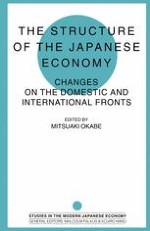1995 | OriginalPaper | Buchkapitel
Bubbles, Bursts and Bailouts: A Comparison of Three Episodes of Financial Crises in Japan
verfasst von : Koichi Hamada
Erschienen in: The Structure of the Japanese Economy
Verlag: Palgrave Macmillan UK
Enthalten in: Professional Book Archive
Aktivieren Sie unsere intelligente Suche, um passende Fachinhalte oder Patente zu finden.
Wählen Sie Textabschnitte aus um mit Künstlicher Intelligenz passenden Patente zu finden. powered by
Markieren Sie Textabschnitte, um KI-gestützt weitere passende Inhalte zu finden. powered by
If we look back at the modern economic history of Japan over almost a century and a half since Japan came out of isolation in 1854, we encounter many dramatic transitions, confusions and even catastrophes in the national economy. There have been several periods of serious inflation: inflation during the 1860s just after the ‘opening up’ of Japan; inflation during 1877–81 caused by a large issue of fiat money and contained by the Matsukata deflation policy; hyper-inflation (1945–9) after the Second World War calmed down by the Dodge plan; and the ‘frenzied price’ period (1973–4) that followed the first oil crisis. Related are several episodes of foreign exchange abnormalities: a large outflow of gold accompanied by a tremendous inflow of Mexican dollars during the 1860s; the economic and political drama relating to the return to the gold standard (1929) followed shortly afterwards by the re-embargo of gold (1931); the adherence to the fixed yen-dollar parity that was broken by President Richard Nixon’s New Economic Policy (1971) and finally led to the adoption of the flexible exchange rate (1973); and the recent excessive co-operative effort to maintain the value of the dollar after the Louvre Accord (1987).
